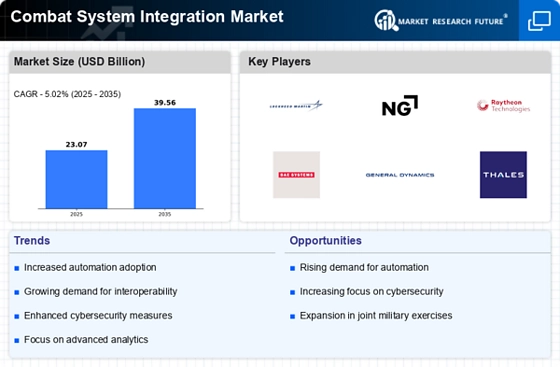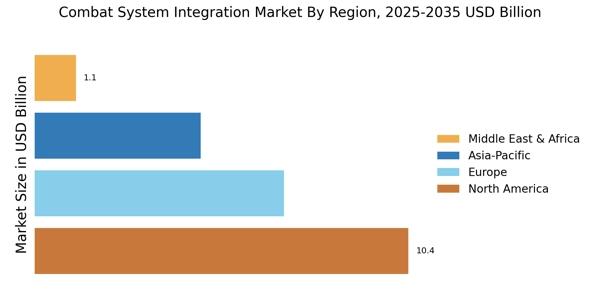Increased Defense Budgets
The Combat System Integration Market is experiencing a notable surge in defense budgets across various nations. Governments are prioritizing military modernization and technological upgrades, which is driving demand for integrated combat systems. For instance, recent reports indicate that defense spending in several countries has increased by an average of 5% annually, reflecting a commitment to enhancing national security. This trend is likely to continue as geopolitical tensions rise, prompting nations to invest in advanced combat capabilities. Consequently, the integration of sophisticated systems becomes essential to ensure interoperability and effectiveness in joint operations. As a result, the Combat System Integration Market is poised for growth, with manufacturers and service providers focusing on innovative solutions to meet the evolving needs of defense forces.
Emerging Threats and Challenges
The Combat System Integration Market is significantly influenced by the emergence of new threats and challenges. As asymmetric warfare and cyber threats become more prevalent, military forces are compelled to adapt their strategies and technologies. This shift necessitates the integration of advanced combat systems that can effectively counter these evolving threats. For example, the rise of unmanned systems and artificial intelligence in warfare has prompted defense organizations to seek integrated solutions that enhance situational awareness and decision-making capabilities. The market is responding to this demand by developing systems that can seamlessly integrate various platforms and technologies, thereby improving operational effectiveness. This focus on addressing emerging threats is likely to drive investment in the Combat System Integration Market, as nations strive to maintain a competitive edge.
Focus on Modular and Scalable Solutions
The Combat System Integration Market is increasingly focusing on modular and scalable solutions to meet the diverse needs of military forces. As defense budgets fluctuate and operational requirements evolve, there is a growing demand for systems that can be easily adapted and upgraded. Modular designs allow for the integration of new technologies without the need for complete system overhauls, thereby providing cost-effective solutions for defense organizations. This flexibility is particularly appealing in an environment where rapid technological advancements are commonplace. Furthermore, scalable solutions enable military forces to tailor their combat systems to specific mission requirements, enhancing operational effectiveness. As a result, the Combat System Integration Market is likely to see a rise in demand for modular and scalable systems that can accommodate future advancements.
International Collaboration and Partnerships
The Combat System Integration Market is witnessing a trend towards international collaboration and partnerships among defense organizations. Countries are increasingly recognizing the benefits of joint exercises and shared technologies to enhance their combat capabilities. Collaborative defense strategies not only facilitate knowledge exchange but also lead to the development of integrated systems that can operate across different platforms. Recent initiatives have seen nations forming alliances to co-develop advanced combat systems, thereby reducing costs and accelerating innovation. This collaborative approach is expected to foster a more integrated defense landscape, where interoperability becomes a key focus. As a result, the Combat System Integration Market is likely to benefit from increased demand for systems that can operate seamlessly within multinational forces.
Advancements in Simulation and Training Technologies
The Combat System Integration Market is being propelled by advancements in simulation and training technologies. As military operations become more complex, the need for effective training solutions has never been more critical. Modern combat systems require personnel to be proficient in operating integrated platforms, which necessitates comprehensive training programs. Innovations in virtual reality and simulation technologies are enabling defense forces to conduct realistic training exercises that mimic real-world scenarios. This not only enhances the readiness of military personnel but also reduces costs associated with traditional training methods. The growing emphasis on effective training solutions is likely to drive demand for integrated combat systems that incorporate these advanced technologies. Consequently, the Combat System Integration Market is expected to see increased investment in simulation and training capabilities.


















Leave a Comment